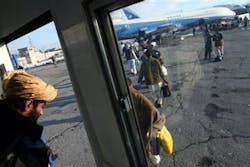Airliners were taking off from Kabul's airport in an unusual spiral pattern Tuesday after a three-day shutdown of commercial flights.
The spiraling takeoffs allow quick altitude gains and are sometimes used to avoid missile fire in war zones. But officials said the new patterns were being used in Kabul airport to allow planes to maintain visual contact with the control tower after a key communications system broke over the weekend.
Tight, spiraling "corkscrew" takeoffs and landings are used in Baghdad, Iraq to avoid possible incoming fire; those in Kabul Tuesday were much wider and more open.
Capt. Nathan Broshear, a U.S. military spokesman, said the corkscrew takeoffs were "normal safety precautions" that might be used at any airport where communications are limited.
He called them "unrelated to any wartime or enemy-related activity."
Najeebullah Maqsoodi, the president of the airport, also said commercial aircraft were making corkscrew takeoffs and landings as a safety precaution because of limited communications.
He said commercial flights were using alternate radio methods to talk to pilots and the main system wouldn't be fixed until U.S. experts arrived from outside the country.
Military flights use a separate communications system and were unaffected by the outage, officials said.
Kabul International Airport closed to commercial traffic over the weekend because of the broken communications system and snowy weather, Maqsoodi said. The closure ordered by the U.S. military, which controls Afghanistan's airspace, irritated some Afghan officials, who said they weren't consulted beforehand.
Michael Boyd, an aviation consultant based in Evergreen, Colo., said the corkscrew takeoffs could be used to quickly gain altitude in the mountainous terrain around Kabul, and allow the control tower to maintain visual contact with planes during the communications problems.
He said another reason for using the procedure could be that planes have to fly over "real estate that's not secure."
An Associated Press reporter on Tuesday saw a landing military cargo plane launch flares, a defensive measure against potential missiles. Maj. Luke Knittig, a spokesman for NATO's International Security Assistance Force, said the use of flares wasn't unusual.
"This is a conflict zone and the flights coming in here do exercise caution commensurate with it being a conflict zone," he said.
Boyd said flares are used "when there is a reasonable expectation of a threat that someone on the ground is aiming something at you," he said.
News stories provided by third parties are not edited by "Site Publication" staff. For suggestions and comments, please click the Contact link at the bottom of this page.






